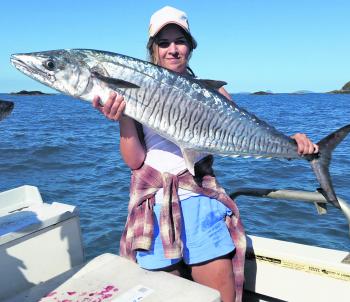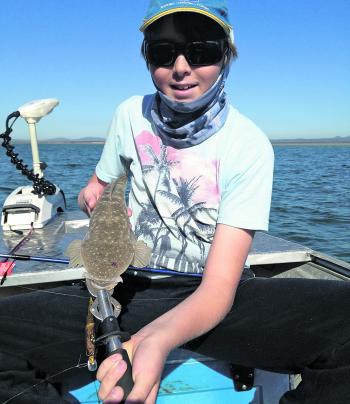2015 is the kind of year that the bay fishers have been wanting for a while. The lack of regular rain has let Keppel Bay clean up so much that we are getting the regular coastal bait fishes coming through in big thick schools.
Ribbonfish (wolf herring) are flooding into spots like Quartz, Ritamada, Ironpot, Rosslyn Bay Harbour and Statue Bay. They are starting to head into Corio Bay where they will probably hang around for a while. We usually use chromies like Flashas to which we’ve added extra-wide gape trebles. This helps with more consistent hook-ups. Ribbonies are great at throwing hooks, often doing an aerial display that barra would be proud of. Lately one of the locals has been taking his wife bait hunting, and she will only use her favourite pink bream and flatty lure. It’s working so well that they now have a bundle of spares in the boat. Wolfies, bonito and doggie mackerel can’t resist them.
We are also getting a big run of northern pilchards. These guys like the cleaner, saltier water and the bigger schools have bypassed the area since the heavy rains from 2008 until this year. Keep an eye on the wind direction and the schools of blue salmon because these two factors can push them up into the smaller coastal estuaries. The bait schools move into the shelter of the creeks on the rising tides. Once in there with the salmon guarding the entrance, the baitfish can get trapped at low tide in the tidal pools. When this happens, the locals simply take a bucket and esky down to the mouth of Ross Creek and score enough really good bait to last a season.
Blue salmon, as expected, are on the boil wherever the baits are. The blues will take pillies, greenback herring and of course northern pillies. Flashas and chrome wobbler style lures also work well on salmon.
One of the by-products of all the bait should be a better than normal lesser mackerel season. Doggies (schoolies), greys and spotted mackerel tend to follow these bait schools and pause in each of the patches that the baits pass on the way. Spotted mackerel are slowly moving along the coast and in to the local area. The islands at the southern end of the bay usually show first, and as September wears on the spotties will work north and give the rest of us a shot. Spotties around here can be caught in both clear and not so clean water, and this makes them available when other mackerels have headed out wider to clearer pastures. Places like Quartz Rock out from Keppel Sands, Cave and Wedge isles just off Emu Park hold spotties for much longer than the other mackerel spots.
Doggies have made some shows at the close spots whenever the conditions have been quiet. The bigger fish have been found at Outer, Barren and Man and Wife. They should be around for a while yet.
Spanish mackerel are still providing plenty of action around the main islands and should remain in some numbers for most the year. Flat, Perforated and Manifold are among our best spots at almost any time. Over the moon and the bigger tides we do get some travellers along with the resident fish in around The Keppels and Liza Jane. It’s easy to spot the difference between the two as the residents are usually fat, greasy and green, ready to travel, while the fish that have just arrived are sleek and silver.
Mackerel of all types prefer a strong run eddying and creating a current line off the corners of islands or reefs. If you prefer to anchor, try to anchor on the line and pull your lures across the movement from the still water. Chromies and slugs work very well with a reasonably quick retrieve. Add a couple of jigs and mackies should follow.
Cobia (black kings) have been around in ones or twos but from now on they’ll arrive in even bigger numbers right around our inshore and offshore waters. They can be in almost plague proportions taking troll baits, floating pillies or baits meant for more highly prized reefies.
Cobia will go for virtually any mackerel style lure or jig. When they are slow or shy they come up and inspect the bait, and if there is something wrong with it they will move on. This is the time to float down an unweighted pilly, a live scad or slimy mackerel. It can be one of those rare occasions where the cobia only have eyes for the more natural presentations.
The bigger reefies including red emperor, large-mouth nannygai (saddletail snapper), coral trout, tuskfish (parrot), red-throat emperor, grassy sweetlip and hussar are all on the chew for the bottom fishers, and we will cover some of them next month.
The estuaries have begun to fire up again after a slight pause during the couple of cold snaps recently. Many of the species are in transition and we are getting quantities of winter and summer specials.
One standout in recent weeks has been mangrove jack. They have been turning up in catches from guys chasing big bream with small live baits. Mullet, herring, hardiheads and prawns are the prime livies. These guys are hard to find in this part of Queensland for some reason, but we do have a couple of serious spots in one or two of the local systems where they tend to hang around. The most common spot is The Causeway Lake in surprisingly shallow water. Once you work out the country they like, look for similar features in other areas and you’ll find more of them. These same principles apply for all types of fish, from barramundi to whiting and everything in between.
September is the peak time for flathead up here. Recent months have been very good, but this month the flatties will be a bit more serious in their aggregation. Corio Bay and Coorooman Creek have big tidal movement of clean water that draws the schools of poddy mullet, hardiheads and greenback herring in large quantities. These are the staple diet of our local flathead and they are where the bait is.
Yabby beds are another spot where flatties like to hang out. They love yabbies and the whiting, small bream, cod and so on that are all there for a feed too.
Flathead are smart fish that use the lay of the creeks to bring the food to them. When you look for flathead spots, look for small eddies and structures out of the main flow or spots that baits have to navigate through or around. Flatties definitely bite better when there is movement in the water. Some of my better spots have the flathead moving onto the banks at one end with the rising tide and moving off the other end with the dropping tide. Lures that suit the depth are the go, and virtually any colour do the job but some days the fish prefer a particular colour or may only take a plastic.
Whiting and bream are going well in many of the estuaries and local beaches. Grunter and king salmon are pick of the fish up the river until the barra fishing picks up a bit more as the weather warms.
Reads: 2803
Angela Cullen with a Spanish mackerel caught out from Yeppoon.

Brendan Reed with a little creek flathead caught on a small minnow lure.

Mark Thompson with a Rocky City winter barra.




